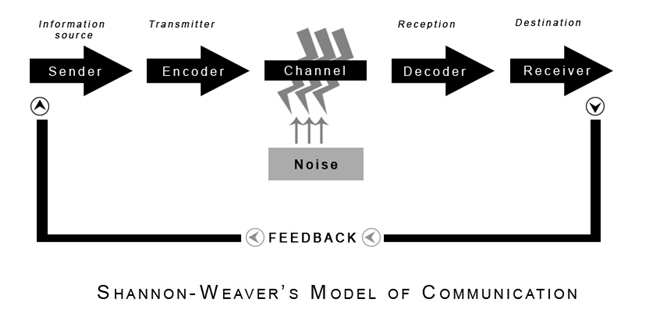AN INTERPERSONAL COMMUNICATION
In 1948, Shannon was an American mathematician, Electronic engineer and Weaver was an American scientist both of them join together to write an article in “Bell System Technical Journal” called “A Mathematical Theory of Communication” and also called as “Shannon-Weaver model of communication”.
This model is specially designed to develop the effective communication between sender and receiver. Also they find factors which affecting the communication process called “Noise”. At first the model was developed to improve the Technical communication. Later it’s widely applied in the field of Communication.
The model deals with various concepts like Information source, transmitter, Noise, channel, message, receiver, channel, information destination, encode and decode.
Sender : The originator of message or the information source selects desire message
Encoder : The transmitter which converts the message into signals
Note: The sender’s messages converted into signals like waves or Binary data which is compactable to transmit the messages through cables or satellites. For example: In telephone the voice is converted into wave signals and it transmits through cables
Decoder : The reception place of the signal which converts signals into message. A reverse process of encode
Note : The receiver converts those binary data or waves into message which is comfortable and understandable for receiver. Otherwise receiver can’t receive the exact message and it will affect the effective communication between sender and receiver
Receiver : The destination of the message from sender
Note : Based on the decoded message the receiver gives their feed back to sender. If the message distracted by noise it will affect the communication flow between sender and receiver
Noise: The messages are transferred from encoder to decoder through channel. During this process the messages may distracted or affected by physical noise like horn sounds, thunder and crowd noise or encoded signals may distract in the channel during the transmission process which affect the communication flow or the receiver may not receive the correct message
Note : The model is clearly deals with external noises only which affect the messages or signals from external sources. For example: If there is any problems occur in network which directly affect the mobile phone communication or distract the messages
Practical Example of Shannon-Weaver model of communication :
Thomson made call to his assistant “come here I want to see you”. During his call, noise appeared (transmission error) and his assistant received “I want” only. Again Assistant asked Thomson (feedback) “what do you want Thomson”.
Sender : Thomson
Encoder : Telephone (Thomson)
Channel : Cable
Noise : Distraction in voice
Reception : Telephone (Assistant)
Receiver : Assistant.
Due to transmission error or noise, Assistant can’t able to understand Thomson’s messages.
*The noise which affect the communication flow between them.
Criticism of Shannon-Weaver model of communication :
1. One of the simplest model and its general applied in various communication theories
2. The model which attracts both academics of Human communication and Information theorist to leads their further research in communication
3. It’s more effective in person-to-person communication than group or mass audience
4. The model based on “Sender and Receiver”. Here sender plays the primary role and receiver plays the secondary role (receive the information or passive)
5. Communication is not a one way process. If it’s behaved like that, it will lose its strength. For example: Audience or receiver who listening a radio, reading the books or watching television is a one way communication because absence of feedback
6. Understanding Noise will helps to solve the various problems in communication

No comments:
Post a Comment